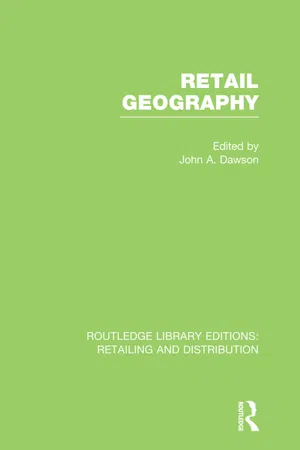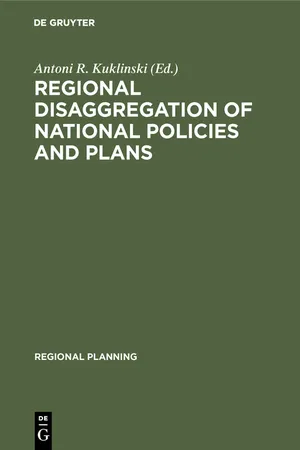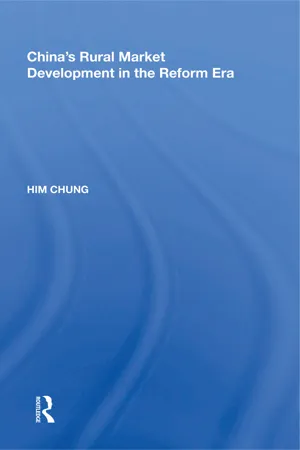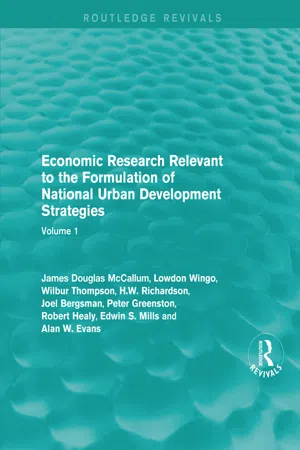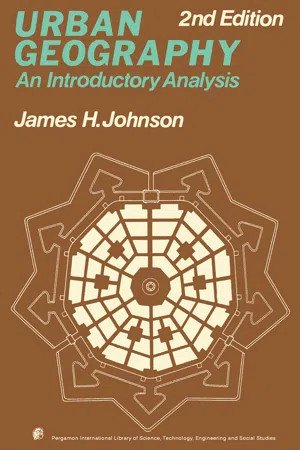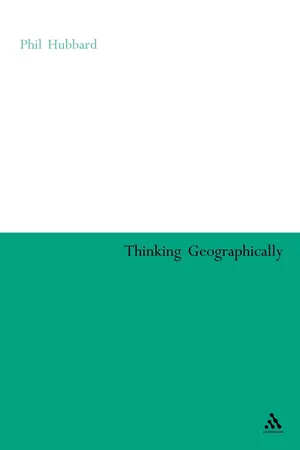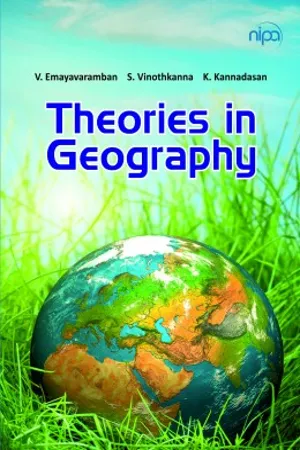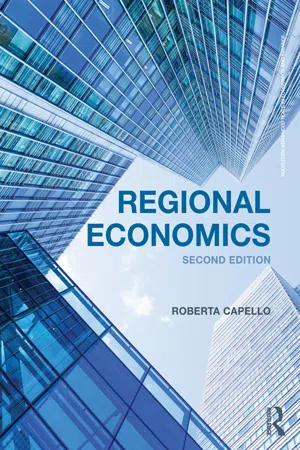Geography
Central Place Theory
Central Place Theory, developed by Walter Christaller, explains the spatial distribution of human settlements and the economic relationships between them. It posits that settlements serve as central places providing goods and services to surrounding areas, with larger settlements offering more specialized and higher-order functions. The theory helps understand the organization and hierarchy of urban and rural centers within a region.
Written by Perlego with AI-assistance
Related key terms
1 of 5
11 Key excerpts on "Central Place Theory"
- eBook - ePub
Marketing Geography (RLE Retailing and Distribution)
With special reference to retailing
- Ross Davies(Author)
- 2012(Publication Date)
- Routledge(Publisher)
However, ‘home’ interview procedures permit more in-depth studies of consumer behaviour and have been extensively used in broader shopping enquiries. An important refinement of this technique is the ‘diary’ type of survey, in which consumers keep actual records of the details of their trips over several days. A ‘diary’ survey undertaken for the city planning department in Cedar Rapids, Iowa, in 1947, 14 subsequently became a major data source for testing various Central Place Theory postulates in America for more than two decades. 15 Central Place Theory Central Place Theory was originally formulated by the German economist and geographer, Walter Christaller, in the early 1930s 16 but its most extensive examination and utilisation in the English-speaking world has occurred in relatively recent times. In general terms, the theory seeks to explain an apparent order in the spatial distribution of urban settlements. This order is most conspicuous in the sizes and spacing of those settlements particularly important for providing goods and services to surrounding populations, and described as central places. The theory, however, does not account for urban growth characteristics arising from industrial or other productive forces. It is concerned much more specifically with explaining regularities in the locations of tertiary activities as these are manifest in business centres - John Dawson(Author)
- 2012(Publication Date)
- Routledge(Publisher)
The dynamic nature of the modern city presents a considerable challenge to Central Place Theory. Improvements in mobility and the growth and dispersal of large metropolitan areas tend to reduce the number of lowest-level centres. New locational forces appear and specialisation replaces the central place hierarchy. Many firms which cluster on specialised locations have not attained an equilibrium because shoppers do not purchase their goods frequently enough and the process of ‘shopping around’ continues indefinitely. In short, ‘the classical patterns of the central place hierarchy break down and are replaced by business patterns characteristically internal to cities’(Berry, 1960).Finally we should be aware of the dangers of using Central Place Theory to analyse the pattern of tertiary activities, or even more narrowly of retailing alone, when this is clearly a partial abstraction from the wider context of other economic locations and activities which constitute the complex reality of the urban scene.In summary, then, Central Place Theory, although a seminal piece of work for the human geographer in general, suffers from severe limitations in the field of retail location. In particular it is a macro-study of location and centre/hinterland relationships which does not easily accommodate the essential micro-scale perspective of individual consumer behaviour. Secondly, it loses much of its validity in the very situation which is of most interest to the retail geographer, that is in the analysis of intra-urban patterns.Spatial Interaction Models
In the study of retail location it is the general field of spatial interaction modelling which comes closest to rivalling Central Place Theory both in terms of the fruitful applications which it yields and of the sheer volume of inputs and outputs which it generates. Most of the models under this heading stem from the gravity concept of human interaction, which is not so much a body of theory as a set of mathematical developments of the basic notion that ‘an attracting force of interaction between two areas of human activity is created by the population masses of the two areas, and a friction against interaction is caused by the intervening space over which the interaction must take place’(Carrothers, 1956).- Antoni R. Kuklinski(Author)
- 2019(Publication Date)
- De Gruyter Mouton(Publisher)
- (1958b), 'Functional bases of the central place hierarchy', Economic Geography. -(1958c), 'Recent Developments of Central Place Theory', Regional Science Associa-tion Papers and Proceedings. -(1958d), 'A note on Central Place Theory and the range of a good', Economic Geo-graphy. Berry, B. J. L. and Pred, A. (1965), Central Place Studies. A Bibliography of Theory and Applications. Philadelphia. Blaug, M. (1964), 'A case of emperors clothes. Perroux's theories of economic domina-tion'. Kyklos. - (1968), Economics of Education. London, Penguin Modern Economics. Bogue, D. J. (1949), The Structure of the Metropolitan Community. A Study of Domi-nance and Subdominance. Ann Arbor. Bos, H. C. (1964), Spatial Dispersion of Economic Activity. Rotterdam. Boudeville, J. R. (1961), Les Espaces Economiques. Paris. - (1966), Problems of Regional Economic Planning. Edinburgh. Böventer, E. von (1963), 'Towards a united theory of spatial economic structure', Regional Science Association Papers and Proceedings. - (1964), 'Spatial organization theory as a basis for regional planning', The A.I.P. Journal. Brown, L. (1968), Diffusion Dynamics. Lund. Bunge, W. (1962), Theoretical Geography. Lund. Cameron, G. C. (1968), 'The regional problem in the United States. Some reflections on a viable strategy', Regional Studies. Carvalho, M. E. F. C. (1969), Regional physical planning in Kenya. A case study, Ekistiks, April. Cassel, G. (1927), Theoretische Sozial-Ekonomie. Leipzig. Christaller, W. (1933, first German edition), Central Places in Southern Germany. Englewood Cliffs, N. J. 1965. Clark, C. (1940), The Conditions of Economic Progress. London. Criteria for Location of Industrial Plants. (1967). New York, United Nations. Datta-Chaudhuri, M. (1969), Regional Development in Southeast Asia: Experiences and Prospects, a Short Summary. Geneva, UNRISD (Mimeographed). Davin, L. E., Degeer, L., and Paelinck, J. (1959), Dynamique Economique de la Région Liègoise. Liège.- Him Chung(Author)
- 2017(Publication Date)
- Routledge(Publisher)
Skinner's use of Central Place Theory to articulate market systems also attracted the attention of anthropologists. Heated discussions took place on this topic during the 1970s, particularly among Stanford anthropologists. Indeed, Central Place Theory, according to Smith (1974, pp.167-168), provided Skinner with a systematic perspective for understanding the marketing behaviour of peasants which was much broader than the usual anthropological view of peasant communities. Subsequently, five aspects of the Central Place Theory have attracted the attention of anthropologists: (a) the delimitation of a village or city as a research unit; (b) the measurement procedures for identifying development at a regional level; (c) the framework for describing trade articulation; (d) the framework for understanding peasant communities; and (e) the ability to tackle economic and social relationships (Smith, 1974, p. 170). As a result, anthropologists "need less modification for the analysis of agrarian marketing", unlike economists and geographers who have to modify the theory's simple assumptions to understand economic activities complicated by modern transport and localised production (Smith, 1974, p. 169). This finding demonstrated Central Place Theory's potential for further elaboration and application in studying China's marketing systems.Market districts pre-1949
The pre-1949 market districts in rural China were regarded by Skinner (1964) as a traditional system, comprising three levels: standard, intermediate and central. The 'standard market' was the core, as it was "the starting point for the upward flow of agricultural products and craft items into higher reaches of the marketing system, and also the termination of the downward flow of imported items destined for peasant consumption" (Skinner, 1964, p.6). It was the first place for peasants to sell their products and to purchase daily necessities. In contrast, the 'central market' was the upper reach of the market hierarchy and located at a key urban node in the transport network. It had important wholesaling functions and served as a highlevel market for exchanging local and imported commodities. As regards the 'intermediate market', Skinner (1964, p.7) does not define it precisely but regards it as having "an intermediate position in the vertical flow of goods and services both ways". The settlements in these market towns were denoted as either a 'standard market town', 'central market town' or 'intermediate market town' respectively.- eBook - ePub
- Tim Hall, Tim Hall, Tim Hall, Heather Barrett(Authors)
- 2018(Publication Date)
- Routledge(Publisher)
neo-classical economic locational theories, adapting and reworking classical land use models, such as those developed by Von Thunen, Christaller, Weber and Losch. Two key strands of research emerged from this: work on urban hierarchies and spheres of influence and work concerned with the distribution of urban land uses (see Carter 1995 for a good overview of this research).Work on urban hierarchies was based primarily on Walter Christaller’s Central Place Theory. Christaller argued that within a region the number, size and distribution of towns was determined by the range and threshold of goods and services. The range of a good is the distance people will travel to purchase it, which is greater for higher value goods. The threshold of a good is the minimum population required to support its continued supply, with higher value goods needing a larger population to support them. Consequently the provision of these goods and services is found within the larger settlements of the hierarchy. Subsequent empirical work, based on these ideas, sought to test whether national, regional and local urban systems existed in clear hierarchies and to examine the spheres of influence of settlements, based on examination of a range of the different functions and services they offered. For example, Berry (1967) looked at the evolution of the central place system in Iowa based on access to a range of retail and service functions, such as clothing and furniture purchases.Work on urban land use built on the development of early urban models, such as Hoyt’s, linking the distribution of land uses to urban land rents, particularly through the concept of the bid-rent curve, where high value commercial land uses were seen to occupy prime accessible locations in the urban centre through their ability to outbid other uses with less need for central locations (Alonso 1964). Developing these ideas, Whitehand (1972) applied the concept of bid-rent to the formation of fringe belts (see chapter three - eBook - PDF
- James Douglas McCallum, Lowdon Wingo, Wilbur Thompson, H.W. Richardson, Joel Bergsman, Peter Greenston, Robert Healy, Edwin S. Mills, Alan W. Evans(Authors)
- 2017(Publication Date)
- Routledge(Publisher)
the central place system. Similarly, the national urban hierarchy performs a number of important functions in the national economy which may make it an efficient medium for the distribution of the total population even if some individual cities in the size distribution are outside the efficient size range from the point of view of the cities when considered alone. Although Central Place Theory, with its emphasis upon supplying central services to the hinterlands around towns, can be used only to explain the regional hierarchy, and then convincingly soley in rural regions, it nevertheless has 7 relevant implications for analysis of the national hierarchy. First, it accounts for the lower orders in the distribution of city sizes since the national hier-archy is merely the sum of all regional hierarchies. The small sub-regional urban centres will feature as low ranking towns in the national system, leaving to be explained in other ways only the system formed by the leading cities in each region and why these assume a hierarchical structure fîrom the standpoint of the national economy. Second, the principle behind Central Place Theory -that industries have market areas of different size - is still of value at the national level. The modifications to the Christaller central place analysis needed for ex-planation of the national hierarchy owe a lot to LÜsch (195*0 > Stolper (1955) 5 Tinbergen (l96l) and 3os (1965). The basic difference is that whereas in the central place hierarchy centres of the same size always produce the same order of goods and services and the industries with large market areas and scale economies are always produced in the larger cities, this is not necessarily the case with the national distribution. City size is positively linked with the number of activities located there and since economies of scale and market area threshold differentials rule out the presence of each industry in each city, we obtain cities of different size. - eBook - PDF
Urban Geography
An Introductory Analysis
- James H. Johnson, W. B. Fisher(Authors)
- 2013(Publication Date)
- Pergamon(Publisher)
If, for some reason or another, the distribution of population is uneven, central places will also be spread unevenly, concentrated in locations accessible to the greatest number of people. But some central places in 82 The Location, Spacing and Size of Urban Settlements 83 favourable locations cater for more people and can offer more special-ized services. These settlements tend to grow progressively larger, their size depending oh their degree of specialization, thus producing various types of central places, characterized by differing populations and zones of influence. Often the resulting hierarchical system exhibits a degree of regularity which has encouraged efforts to formulate generalizations about the distribution and size of central places. Indeed, this matter is so important and has been given so much attention by geographers that it must be returned to later in this chapter. A second factor governing the location of urban settlements is the distribution of through transport routes and break-of-bulk points along them. Incidental to its primary function, a through transport route often modifies the pattern of local accessibility in an area, since it can hardly fail to have an effect on local transport facilities. As a result a through transport route can distort the central place arrangement of the cities and towns near to it. In Britain, for example, the London to Birmingham motorway, designed to connect two major conurbations, has also had a considerable impact on the local accessibility of towns close to its route. Transport routes are most influential in governing the location of cities which link regions to external areas. Often the dominating metro-polis of a region has had its origin as a transport centre, although later urban growth has attracted so many other functions that this original stimulus to its development has been masked. - eBook - PDF
- Brendan Bartley, Phil Hubbard, Rob Kitchin(Authors)
- 2004(Publication Date)
- Continuum(Publisher)
16 Theorizing Human Geographies 1.3.2 Place As with space, place, until relatively recently, was theorized purely in absolute terms. Within this tradition (as adopted by regional and quantitative geog-raphy), place was understood merely as a gathering of people in a bounded locale (territory) -literally a portion of geographic space (Duncan, 2000). Place was thus conceived as a unique site that, while connected to other places, could be understood as a largely self-contained unit. This unit, because of its salience to the people living there, gave rise to a 'sense of place' which itself could be studied as a phenomenon unique to that locale. For example, during the 1970s, geographers adopting humanistic approaches (see Section 2.3) began to undermine the absolute conception of place in two ways. First, these humanist approaches saw place as more subjectively defined. As such, what constituted a place was seen to be largely individualistic, although attachments and meanings were often shared. A place meant different things to different people. This led Agnew (1987) and Entrikin (1991) to provide working definitions that mediated between objective and subjective understandings of place. Entrikin (1991), for example, argued that place is both the external context of our actions and a centre of meaning; there is a tension between subjective and objective concep-tions of place that has to be accommodated in theorizing and researching geographic questions. Agnew (1987) identifies three main elements of place, the first two objective, the last subjective: 1. Locale -the settings in which social relations are constituted; 2. Location -the objective geographical area encompassing the setting for social interaction as defined by social and economic processes operating at a wider scale. 3. Sense of place — the local structure of subjective feeling associated with an area. - eBook - PDF
- V. Emayavaramban, K. Kannadasan, S. Vinothkanna(Authors)
- 2021(Publication Date)
4. Christaller’s theory gives a better understanding of retail business and services whereas the Loschian economic landscape explains the spatial distribution of market based manufacturing. 5. Christaller assumes minimum transportation cost on the multipurpose journeys of consumers for the economies of agglomeration. Losch did not stipulate any such condition. 6. Christaller’s pattern is best suited for understanding those cities which developed in sparse settlement region. While Losch’s theory is better suited for understanding economic change in densely populated regions. Central Place Systems in India The key elements of the system of central places are hierarchy and ordering of settlements and even spacing of settlements of different levels under specific circumstances. India represents hierarchy from the point of view of administration and demography. From the point of view of administration, India has a six level hierarchy of settlements. At the top of the hierarchy is the national capital followed by state capitals, district headquarters, tehsil towns, block development centres and gram panchayat centres. The national and state capitals are metropolitan cities, district centres and tehsil towns are recognised urban places (see Appendix) while block headquarters are large villages having a population of 5000 and most of them are not recognised urban places. The administrative hierarchy of settlements in India differ considerably from the central place system under the administrative principle of Christaller. Theoretically, there is a ratio of 1:7 between the number of settlements of higher and lower orders. In India, the ratio of districts to states is almost 1: 19, while there may be as many as 40 gram panchayats per community development block. The number of tehsils per district is slightly over six and this corresponds to the administrative principle somewhat closely. - eBook - ePub
- Roberta Capello(Author)
- 2015(Publication Date)
- Taylor & Francis(Publisher)
It is still too early for the city network paradigm to be called a theory, given that it still lacks adequate theorization. However, it seems certain to flank (and in certain respects supersede) Christaller’s traditional territorial approach to the study of urban systems and their evolution. It is beyond doubt, in fact, that the paradigm represents a major theoretical advance on the urban hierarchy model. A good example of its interpretative force is its ability to sever the mechanistic relation between specialization and city size imposed by Christaller’s model. It explains, for example, why Zurich, a city of only 360,000 inhabitants, fulfils a function of prime importance in international finance together with megalopolises like New York and Tokyo; a circumstance impossible to conceive or explain on the logic of Christaller’s hierarchical model.3.7 ConclusionsThe chapter has analysed theories able to interpret the economic reasons for the existence of urban systems made up of cities of different sizes, and in doing so to remedy the evident limitations of other approaches, in particular those described in Chapter 2 . Central place theories and the seminal works of Christaller and Lösch explain how urban systems organize themselves on the territory according to strict economic principles. Their merits and shortcomings have been analysed, and the most recent advances in Central Place Theory rectifying the weaknesses of the original models have been outlined.The chapter has concluded with discussion of ‘city networks theory’, which is the most recent conceptualization of the organization of urban systems. This approach no longer interprets urban systems in terms of purely hierarchical relations among cities (which allow for control over non-overlapping market areas embedded in each other). It instead envisages horizontal relations among urban areas of the same size and performing similar functions. These relations exist in the real world but do not find theoretical explanation in Christaller’s model. Although this approach yields a conceptual interpretation of evident real phenomena, it is still a paradigm that lacks an adequate theory that would give it wider scientific recognition. - eBook - PDF
Human Geography
People, Place, and Culture
- Erin H. Fouberg, Alexander B. Murphy(Authors)
- 2020(Publication Date)
- Wiley(Publisher)
In our study of urban geography in this chapter, we look at the city spatially, examining the forms of cities around the world, the role of people in building and shaping cities, and the changes that cities have undergone over space and time. CHAPTER OUTLINE 9.1 Describe the sites and situations of cities. • The Hearths of Urbanization • Site and Situation 9.2 Analyze the distribution of cities and their relative size. • The Rank-Size Rule and Primate Cities • Central Place Theory 9.3 Explain the internal structure of cities and compare urban models. • Zones in Cities • The European City Model • The North American City Model • The Latin American City Model • The African City Model • The Southeast Asian City Model 9.4 Analyze how political and economic policies shape cities. • Redlining, Blockbusting, and White Flight • Gentrification • Urban Sprawl and New Urbanism • Gated Communities • Urban Geopolitics 9.5 Explain what world cities are and describe how they shape and reflect globalization. • Megacities and Global Slums CHAPTER 9 FIGURE 9.1 Dublin, Ireland. Dublin residents organized a Take Back the City demonstration to protest the city’s housing crisis. Take Back the City is a conglomeration of 15 housing groups whose members are concerned about the cost and availability of housing for the city’s residents. Each flat and house a developer buys to lease through home- sharing platforms is another residence not available for locals to rent or buy. PA Images/Alamy Stock Photo Urban Geography 262 CHAPTER 9 Urban Geography over 50 percent of Chinese living in cities, but India is mostly rural, with 70 percent of Indians living in rural areas. The large concentration of people in cities gives people access to goods, services, and opportunities not available in rural areas.
Index pages curate the most relevant extracts from our library of academic textbooks. They’ve been created using an in-house natural language model (NLM), each adding context and meaning to key research topics.

